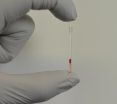(Press-News.org) Television shows filled with action and sound may be bad for your waistline. TV viewers ate more M&Ms, cookies, carrots and grapes while watching an excerpt from a Hollywood action film than those watching an interview program.
Television has been blamed for helping Americans to gain weight because it encourages a sedentary lifestyle. But the focus of why has been on the medium and not the message. TV is like other distracting activities that can cause people to eat more, including reading, listening to the radio and interacting with dinner companions. However, little is known about whether the content or pace of the content influences how much people eat.
The authors examined how objective technical characteristics, such as the frequency of visual camera cuts or variations in sound, might influence how much food is eaten. Their study, which was highlighted in a research letter, included 94 undergraduate students (57 female; mean age nearly 20 years). They gathered in groups to watch 20 minutes of TV and were randomly assigned to 1 of 3 different programs: an excerpt from "The Island," a Hollywood action movie starring Ewan McGregor and Scarlett Johansson, the interview program "Charlie Rose," or the identical excerpt from "The Island" but with no sound. Viewers had M&Ms, cookies, carrots and grapes to snack on while watching. The snacks were weighed before and after the program to track how much viewers had eaten.
Viewers watching the more distracting program "The Island," with its high camera cuts and sound variation, ate 98 percent more grams of food (206.5 vs. 104.3 g) and 65 percent more calories (354.1 vs. 214.6) than viewers who watched "Charlie Rose." Even viewers of the silent version of "The Island" ate 36 percent more grams of food (142.1 vs. 104.3g) and 46 percent more calories (314.5 vs. 214.6) than "Charlie Rose" viewers.
"More distracting TV content appears to increase food consumption: action and sound variation are bad for one's diet. The more distracting a TV show, the less attention people appear to pay to eating, and the more they eat."
INFORMATION:
Author: Aner Tal, Ph.D., of Cornell University, Ithaca, N.Y., and colleagues.
(JAMA Intern Med. Published online September 1, 2014. doi:10.1001/jamainternmed.2014.4098. Available pre-embargo to the media at http://media.jamanetwork.com.)
Editor's Note: This research was made possible by support from Cornell University. Please see the article for additional information, including other authors, author contributions and affiliations, financial disclosures, funding and support, etc.
Media Advisory: To contact corresponding author Aner Tal, Ph.D., call Melissa Osgood at 607-255-2059 or email mmo59@cornell.edu.
Research letter: Viewers ate more while watching Hollywood action flick on TV
2014-09-01
ELSE PRESS RELEASES FROM THIS DATE:
Quality of US diet improves, gap widens for quality between rich and poor
2014-09-01
The quality of the U.S. diet showed some modest improvement in the last decade in large measure because of a reduction in the consumption of unhealthy trans fats, but the gap in overall diet quality widened between the rich and the poor.
An unhealthy diet is closely linked to cardiovascular disease, diabetes and some cancers. Eating a healthy diet is an important part of the strategy to prevent adverse health outcomes. Evaluating population trends in diet quality is important because it can offer guidance for public health policy.
The authors used the Alternate ...
Family dinners good for teens' mental health, could protect from cyberbullying
2014-09-01
Bottom Line: Cyberbullying was associated with mental health and substance use problems in adolescents but family dinners may help protect teens from the consequences of cyberbullying and also be beneficial for their mental health.
Author: Frank J. Elgar, Ph.D., of McGill University, Montreal, Canada, and colleagues.
Background: About 1 in 5 adolescents has experienced recent online bullying and cyberbullying, like traditional bullying, can increase the risk of mental health problems in teens as well as the misuse of drugs and alcohol. It is important to understand ...
Engineers develop new sensor to detect tiny individual nanoparticles
2014-09-01
Nanoparticles, engineered materials about a billionth of a meter in size, are around us every day. Although they are tiny, they can benefit human health, as in some innovative early cancer treatments, but they can also interfere with it through viruses, air pollution, traffic emissions, cosmetics, sunscreen and electronics.
A team of researchers at Washington University in St. Louis, led by Lan Yang, PhD, the Das Family Career Development Associate Professor in Electrical & Systems Engineering, and their collaborators at Tsinghua University in China have developed a new ...
Sierra Nevada freshwater runoff could drop 26 percent by 2100, UC study finds
2014-09-01
Irvine, Calif. — Freshwater runoff from the Sierra Nevada may decrease by as much as one-quarter by 2100 due to climate warming on the high slopes, according to scientists at UC Irvine and UC Merced.
Accelerated plant growth at higher elevations caused by increasing temperatures would trigger more water absorption and evaporation, accounting for the projected runoff declines, the researchers add.
A diminished river flow will only add to the burden of providing resources to the thirsty farms and homes that rely on it. The state is currently experiencing a severe drought, ...
Nature's tiny engineers
2014-09-01
CAMBRIDGE, Mass-- Conventional wisdom has long held that corals — whose calcium-carbonate skeletons form the foundation of coral reefs — are passive organisms that rely entirely on ocean currents to deliver dissolved substances, such as nutrients and oxygen. But now scientists at MIT and the Weizmann Institute of Science (WIS) in Israel have found that they are far from passive, engineering their environment to sweep water into turbulent patterns that greatly enhance their ability to exchange nutrients and dissolved gases with their environment.
"These microenvironmental ...
Location of body fat can increase hypertension risk
2014-09-01
WASHINGTON (Sept. 1, 2014) — People with fat around their abdominal area are at greater risk of developing hypertension when compared to those with similar body mass index but fat concentrations elsewhere on the body, according to a study published today in the Journal of the American College of Cardiology.
Obesity is a known risk factor for hypertension, or high blood pressure, and it is widely reported that the location of fat on a person's body can lead to increased risk of other health issues like heart disease and cancer. However, the relationship between hypertension ...
Ride-sharing could cut cabs' road time by 30 percent
2014-09-01
CAMBRIDGE, Mass-- Cellphone apps that find users car rides in real time are exploding in popularity: The car-service company Uber was recently valued at $18 billion, and even as it faces legal wrangles, a number of companies that provide similar services with licensed taxi cabs have sprung up.
What if the taxi-service app on your cellphone had a button on it that let you indicate that you were willing to share a ride with another passenger? How drastically could cab-sharing reduce traffic, fares, and carbon dioxide emissions?
Authoritatively answering that question ...
Faster, cheaper tests for sickle cell
2014-09-01
Within minutes after birth, every child in the U.S. undergoes a battery of tests designed to diagnose a host of conditions, including sickle cell disease. Thousands of children born in the developing world, however, aren't so lucky, meaning many suffer and die from the disease each year.
A.J. Kumar hopes to put a halt to at least some of those deaths.
A Post-Doctoral Fellow in Chemistry and Chemical Biology working in the lab of George Whitesides, the Woodford L. and Ann A. Flowers University Professor, Kumar and colleagues, including other co-authors, have developed ...
Training your brain to prefer healthy foods
2014-09-01
BOSTON (September 1, 2014, 10:20 AM EDT) — It may be possible to train the brain to prefer healthy low-calorie foods over unhealthy higher-calorie foods, according to new research by scientists at the Jean Mayer USDA Human Nutrition Research Center on Aging (USDA HNRCA) at Tufts University and at Massachusetts General Hospital. Published online today in the journal Nutrition & Diabetes, a brain scan study in adult men and women suggests that it is possible to reverse the addictive power of unhealthy food while also increasing preference for healthy foods.
"We don't start ...
Fruit consumption cuts CVD risk by up to 40 percent
2014-09-01
Barcelona, Spain – Monday 1 September 2014: Daily fruit consumption cuts the risk of cardiovascular disease (CVD) by up to 40%, according to research presented at ESC Congress today by Dr Huaidong Du from Oxford, UK. The findings from the seven year follow-up study of nearly 0.5 million people in the China Kadoorie Biobank found that the more fruit people ate, the more their risk of CVD declined.
Dr Du said: "CVD, including ischaemic heart disease (IHD) and stroke, is the leading cause of death worldwide. Improving diet and lifestyle is critical for CVD risk reduction ...


